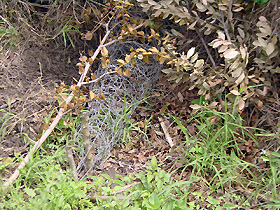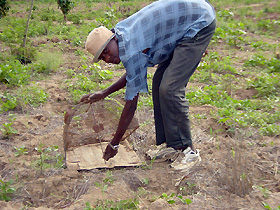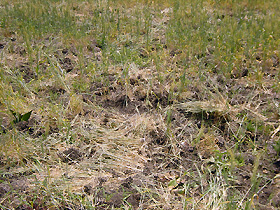| Period: 8 August 2005 - 8 Janurary 2006. Country: Kenya |
| (1) Human-Wildlife Conflict in the Nyeri District of Kenya: A Case Study of Mahiga 'B' Village |
| MUTUA, Charles Musyoki (Division
of African Area Studies) |
| Key Words: Conservation, Livelihood, Crop damage, Elephant migration, Economic losses |
(2) The nature of conflicts between people and wildlife at local levels is not fully understood. Conflict resolution
is constrained by inadequate understanding of the realities that surround particular areas that are prone to human-wildlife conflict. This study focuses on
wildlife conservation in Kenya and its impact on the livelihoods of residents of Mahiga 'B' village in the southwestern reaches of Mount Kenya, with special
reference to elephant migration.

Photo 1: Trap for porcupines. |

Photo 2: A farmer preparing a trap for squirrels. |

Photo 3: Wheat farm damaged by elephants. |
(3) The study was conducted from 8 August 2005 to 8 January 2006. The fieldwork was done in Mahiga 'B' village in Nyeri District, Kenya.
1. An outline of the villagers' livelihood:
The residents of the village are predominantly farmers who cultivate maize, kidney beans, Irish potatoes and wheat as their main crops. They also keep livestock such as cattle,
sheep and goats. Income from the sale of milk constitutes an important source of income. Additional income is obtained from the sale of sheep or goats. A negligible number of
the villagers have permanent employment, with a majority of the men engaging in freelance low paying jobs. The women are predominantly farmers with a few engaging in other
economic activities such as teaching and casual labor in the village.
2. Background of human-wildlife conflict:
The village is situated in an area that has traditionally been utilized by elephants migrating between Mount Kenya and the Aberdare mountain ranges.
Solio and Sangare are livestock rearing ranches that provide appropriate habitat to a diverse range of wildlife including elephants, buffaloes, rhinos,
elands, giraffes, bush pigs, cheetahs, hyenas, etc. Wildlife that are either residents or transient (elephants) in these livestock ranches invade the village farms,
attack cultivated crops and damage infrastructure, leading to economic, opportunity and social losses to the farmers.
A serious conflict of interest exists between the farmers, the ranch owners and the government over this situation. The ranches derive economic benefits from the presence
of wildlife, while the farmers incur social and economic losses. The government is committed to wildlife conservation because of the immense contribution it makes to the
country's GDP through tourism.
3. Crop damage:
From August to December 2005, yellow-necked spur fowls, Cape rooks and squirrels were responsible for the loss of 44.1% of sowed maize seeds.
Speckled mouse birds, grey duikers, Kori bustards, Cape hares and elephants (by trampling) attacked emergent cotyledons and leaves of
germinating beans. The total acreage under germinating beans damaged was 8,942m2. Elephants (uprooted seeds but did not consume), porcupines,
yellow-necked spur fowls and bushbucks attacked sowed seeds of Irish potatoes. The total acreage under Irish potatoes damaged was 178m2.
In 2004 and 2005, elephants attacked mature maize, beans, wheat and Irish potatoes. The highest acreage damaged by elephants in both years was under maize (43,453m2),
followed by wheat (14,595m2), then by beans (14,389m2) and then by Irish potatoes (3,458m2). Damage to maize accounted for about 57.3% of the total acreage under
crops damaged.
4. Economic losses of crops due to wildlife:
4.1 Elephant related:
In 2004 and 2005, the residents incurred economic losses due to elephant attacks on mature crops amounting to approximately US$17,000. The total crop economic loss to
elephants increased by 78.0% from 2004 to 2005, indicating that the conflict is worsening. Damage to maize accounted for 54.0% of the total economic losses to crops,
followed by wheat (20.9%), kidney beans (16.8%) and Irish potatoes (8.3%).
4.2 Other wildlife:
The economic losses due to wildlife attacks on sowed maize seeds, young kidney beans and Irish potato seeds were relatively low (US$ 307.7) compared to the losses to
elephants. Speckled mouse birds, yellow-necked spurfowls, Cape rooks, grey duikers, bushbucks, Cape hares and porcupines principally caused overall, economic losses
to young crops from August to December 2005.
5. Vulnerability of households:
Crop loss varied considerably in the amount of damage suffered between households. In the case of damage to germinating beans, an overall loss of 8.3% of total
cultivated acreage occurred. Losses to individual households ranged from 0.004% to 57.3% of cultivated acreage. But 10 of 38 affected households incurred 70.0% of
the total loss. An overall loss of 3.3% of the total acreage under Irish potatoes occurred. Irish potato losses to individual households ranged from 0.6% to 5.4%
of cultivated acreage. Of the six households affected three incurred 90.2 % of the total loss. Whereas fifty-seven households incurred an overall loss of 44.1% of
sowed maize seeds, four households lost 100% of the sowed seeds.
Two households incurred 41.3% of the overall damage by elephants on mature maize, beans, wheat and Irish potatoes (N=35) in 2004 and 2005. Over the same period the same two
households incurred 45.3% of the total economic loss due to elephant attacks on crops.
6. Predicting spatial patterns of crop raiding:
6.1 Proximity to Solio ranch:
Proximity of cultivated fields to Solio ranch was the strongest predictor of crop raiding by elephants. When data of acreages under all types of crops damaged by
elephants in 2004 and 2005 were collated, 74.7% of the acreage damaged was within 400m of the boundary of Solio ranch. Over the same period, households lying within
400m of the boundary of Solio ranch incurred 74.4% of the total economic cost of crops damaged by elephants.
There was a negative correlation between the number of species that visited each farm and the distance from Solio ranch (r=-0.306, df=60, P=0.002). This indicated that the
closer a farm was to Solio ranch, the more the species that attacked crops in the farm.
There was a negative correlation between the number of defence methods employed by individual households and the distance from Solio ranch (r=-0.421, P=0.001, df=62). This
indicated that households close to Solio ranch employed more defence methods than households further away from Solio.
6.2 Nature of vegetation on and along perimeter boundaries of fields, and neighbouring cultivated fields:
Factors within the village also contributed to significant losses in crops. On the thirty-eight farms where damage to germinating beans by wildlife occurred
during the August 2005 to January 2006 agricultural season; damage to the bean plants occurred along the edges of the farms in 97.2% of the farms.
Farms with trees growing in the cultivated area incurred more damage to germinating beans that farms without trees (t=3.032, df=13, P=0.010). Of the farms where germinating
beans were damaged, 79.1% had trees and/or bushes growing along the perimeter boundaries (N=38).
The vegetation on, along perimeter fences or neighbouring farms provided a safety cover from which wildlife could attack crops with a minimal risk of being sighted.
|



 21st Century COE Program
-Aiming for COE of Integrated Area Studies-
21st Century COE Program
-Aiming for COE of Integrated Area Studies-